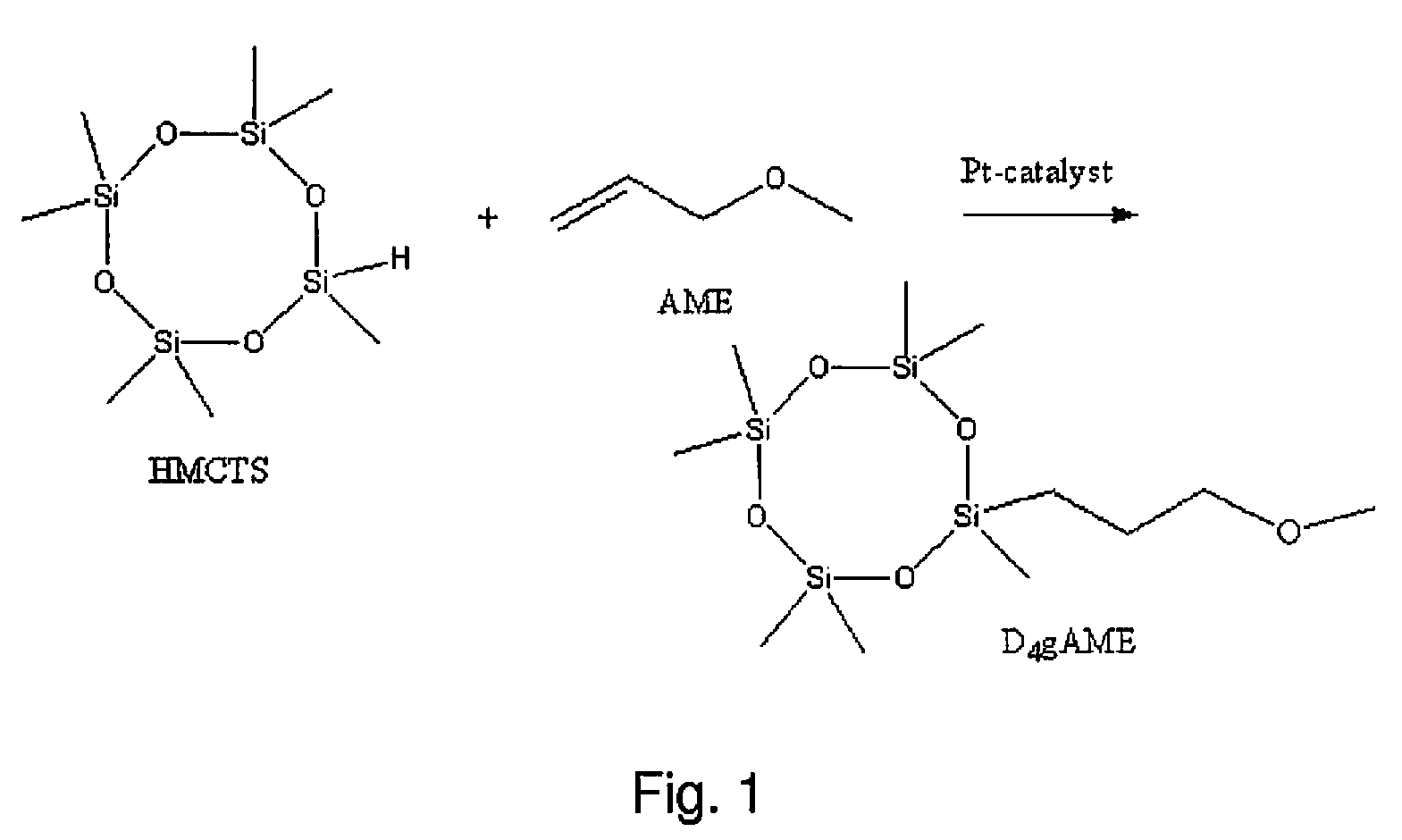Use of tocopherol
a tocopherol and a technology of tocopherol, applied in the field of tocopherol use, can solve the problems of large amount of catalyst, inability to use all drugs, polymer cross-linking, etc., and achieve the effect of reducing the amount of catalyst and reducing the cross-linking of polymers
- Summary
- Abstract
- Description
- Claims
- Application Information
AI Technical Summary
Benefits of technology
Problems solved by technology
Method used
Image
Examples
example 1
Starting Chemicals
[0068]Substituent: Allylethylether (Aldrich)[0069]Starting siloxane: Heptamethylcyclotetrasiloxane (Clariant)[0070]Catalyst of the monomer synthesis: Pt-divinyltetramethyldisiloxane, 2.3 wt-% of Pt in xylene (ABCR)[0071]Polymerisation catalyst: Phosphazene base (1-tert-butyl-4,4,4-tris(dimethylamino)-2,2-bis[tris(dimethylamino)-phosphoranylidenamino]-2Δ5,4Δ5-catenadi(phosphazene) (Fluka Chimika)[0072]Co-catalyst: D′L-α-tocopherol (Roche)[0073]Vinylcomonomer: 1,3,5,7-tetravinyl-1,3,5,7-tetramethylcyclotetrasiloxane, MV4 (Gelest)[0074]End blocker: Vinyl terminated poly(dimethylsiloxane), DMS-V21 (ABOR)[0075]Polymerisation catalyst deactivator: tris(trimethylsilyl)phosphate (Fluka Chimika)
Monomer Synthesis
[0076]Heptamethylcyclotetrasiloxane and allylethylether were weighed in a 50 ml glass round bottom vessel equipped with reflux condenser, the stoichiometric relation used was 1.1:1 (vinyl:SiH). The vessel was placed in an oil bath and nitrogen was purged through the ...
example 2
Starting Chemicals
[0080]Substituent: n-Butylvinylether (BASF)[0081]Starting siloxane: Heptamethylcyclotetrasiloxane (Clariant)[0082]Catalyst of the monomer synthesis: Pt-divinyltetramethylidisiloxane, 2.3 wt-% of Pt in xylene (ABCR)[0083]Polymerisation catalyst: Phosphazene base (1-tert-butyl-4,4,4-tris(dimethylamino[0084]End blocker: 1,1,3,3-tetravinyldimethyldisiloxane (ABCR)[0085]Polymerisation catalyst deactivator: tris(trimethylsilyl)phosphate (Fluka Chimika) )-2,2-bis[tris(dimethylamino)-phosphoranylidenamino]-2Δ5,4Δ5-catenadi(phosphazene) (Fluka Chimika)[0086]Vinylcomonomer: 1,3,5,7-tetravinyl-1,3,5,7-tetramethylcyclotetrasiloxane, MV4 (Gelest)[0087]End blocker: 1,1,3,3-tetravinyldimethyldisiloxane (ABCR)[0088]Polymerisation catalyst deactivator: tris(trimethylsilyl)phosphate (Fluka Chimika)
Monomer Synthesis
[0089]The same steps as in Example 1 were used for the monomer synthesis. The substituent (n-butylvinylether) used made the reaction proceed much faster (total time 0.5 h)...
example 3
Starting Chemicals
[0091]Substituent: n-Butylvinyl ether (BASF)[0092]Starting siloxane: Heptamethylcyclotetrasiloxane (Clariant)[0093]Catalyst of the monomer synthesis: Pt-divinyltetramethyldisiloxane, 2.3 wt-% of Pt in xylene (ABCR)[0094]Polymerisation catalyst: Phosphazene base (1-tert-butyl-4,4,4-tris(dimethylamino)-2,2-bis[tris(dimethylamino)-phosphoranylidenamino]-2Δ5,4Δ6-catenadi(phosphazene) (Fluka Chimika)[0095]Co-catalyst: D′L-α-tocopherol (Roche)[0096]Vinylcomonomer: 1,3,5,7-tetravinyl-1,3,5,7-tetramethylcyclotetrasiloxane, MV4 (Gelest)[0097]End blocker: 1,1,3,3-tetravinyldimethylsiloxane, (ABCR)[0098]Polymerisation catalyst deactivator: tris(trimethylsilyl)phosphate (Fluka Chimika)
Monomer Synthesis
[0099]The same steps as in Example 1 were used for the monomer synthesis. This time with different substituent (n-Butylvinyl ether) the reaction was much faster and it was complete after 0.5 h. No Si—H groups were remaining according to FT-IR.
Polymerisation of 1,1-3,3-5,5-7-hepta...
PUM
| Property | Measurement | Unit |
|---|---|---|
| temperature | aaaaa | aaaaa |
| temperature | aaaaa | aaaaa |
| temperature | aaaaa | aaaaa |
Abstract
Description
Claims
Application Information
 Login to View More
Login to View More - R&D
- Intellectual Property
- Life Sciences
- Materials
- Tech Scout
- Unparalleled Data Quality
- Higher Quality Content
- 60% Fewer Hallucinations
Browse by: Latest US Patents, China's latest patents, Technical Efficacy Thesaurus, Application Domain, Technology Topic, Popular Technical Reports.
© 2025 PatSnap. All rights reserved.Legal|Privacy policy|Modern Slavery Act Transparency Statement|Sitemap|About US| Contact US: help@patsnap.com



